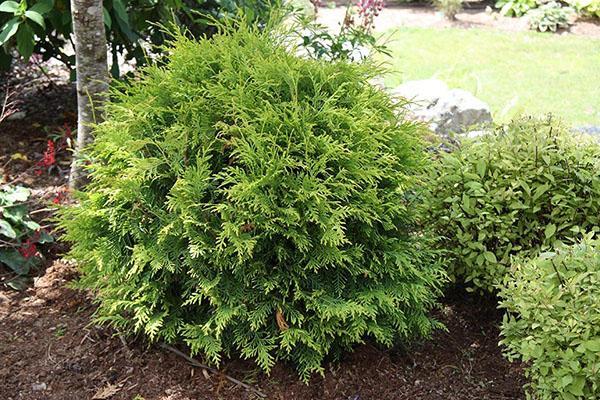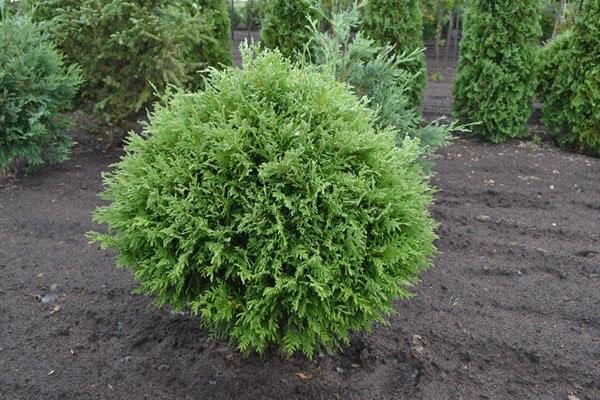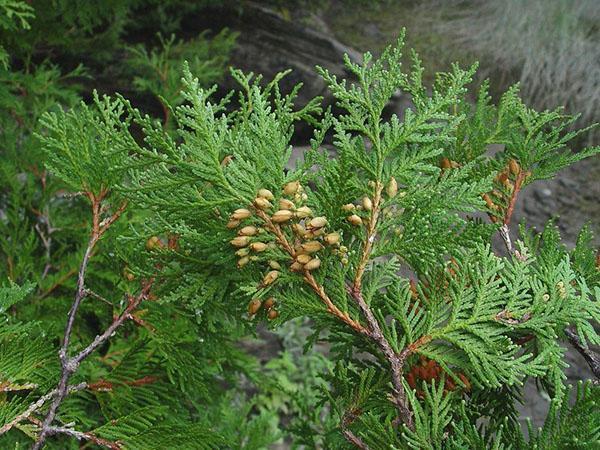The nuances of planting and caring for Woodwardi thuja in the garden
 Tui with a rounded crown traditionally become the center of attraction for eyes, wherever they are. Thuja Woodwardi is one of the old, well-proven varieties with a dense crown, a livable character and a noticeable appearance that turns the shrub into a bright "star" of group and specimen plantings.
Tui with a rounded crown traditionally become the center of attraction for eyes, wherever they are. Thuja Woodwardi is one of the old, well-proven varieties with a dense crown, a livable character and a noticeable appearance that turns the shrub into a bright "star" of group and specimen plantings.
Thuja western - the leader in popularity among conifers, suitable for growing in private gardens, city squares and containers. Russians value culture:
- for high decorativeness;
- for a small annual increase, which allows you to save time on a haircut;
- thanks to easy care;
- for excellent winter hardiness;
- for maintaining attractiveness both in summer and winter.

In the conditions of the middle zone, the ephedra has established itself as a real long-liver, withstanding frosts, hot summers and even the polluted air of megalopolises.
Description of thuja Woodwardy
 Today, the owners of suburban areas have dozens of varieties of conifers at their disposal. Thuja Woodwardii or Thuja occidentalis Woodwardii belongs to the varieties that have repeatedly been able to confirm their value in landscape design... The first mentions of a variety of Canadian origin date back to the 20s of the last century.
Today, the owners of suburban areas have dozens of varieties of conifers at their disposal. Thuja Woodwardii or Thuja occidentalis Woodwardii belongs to the varieties that have repeatedly been able to confirm their value in landscape design... The first mentions of a variety of Canadian origin date back to the 20s of the last century.
Once in the Old World, the ephedra quickly won the recognition of European gardeners. There were several reasons for this, but the main ones can be listed in several points:
- rich, unchanging color of scaly needles;
- dense crown, which in young plants has a spherical shape, and in adults, due to a small vertical growth, becomes more squat;
- excellent adaptability to the most unassuming conditions;
- undemanding after landing, which is important both in large parks and on small private estates.
Planted in the ground at the age of 2-3 years, the shrub grows to a height of one and a half meters only by 10 years. Subsequently, growth continues, but its rates become even lower.
The maximum height that Woodward's thuja reaches is 2–2.5 meters with a crown diameter of about three meters.
The branches of the shrub are flattened, with a large number of green shoots, covered with scaly needles. Its color can range from light to dark green and depends on growing conditions, branch age and season. On adult specimens, fruits appear - brownish-brown oblong cones, collected in loose panicles.
 According to the description of thuja Woodwardi, like its closest relatives, it is a light-loving evergreen crop that prefers cultivated light soils. For good growth and maintaining decorativeness, the ephedra needs not only light, but also water. However, moisture stagnation under the roots greatly increases the likelihood of rot and fungus at the base of the trunk and in the depths of the crown.
According to the description of thuja Woodwardi, like its closest relatives, it is a light-loving evergreen crop that prefers cultivated light soils. For good growth and maintaining decorativeness, the ephedra needs not only light, but also water. However, moisture stagnation under the roots greatly increases the likelihood of rot and fungus at the base of the trunk and in the depths of the crown.
Thuja of this variety can withstand winter frosts in almost the entire territory of Russia. For adult shrubs, a snow cover is enough, and young plants in the first 2-3 years are additionally covered with burlap so that they do not suffer from dry cold and sunny spring burns.
Features of planting and caring for Woodwardi thuja
At the place chosen for planting thuja, planting holes or trenches of 60–80 cm are dug. If a large seedling or an adult shrub is to be planted, the diameter and depth are increased, focusing on the size of its root system.
 Thuja needs a loose cultivated soil with good drainage. Therefore, garden soil, humus and peat... Heavy and dense soils are mixed with sand and peat. In areas with flooding or stagnant water in the ground, the thuja will inevitably hurt and die. In such cases, an elevation and reliable drainage are made in advance to drain excess moisture. At the bottom of the planting pit, a layer of sand, broken brick or expanded clay about 15 cm thick will help. 50-60 grams of complex fertilizer for coniferous crops is added to the soil mixture for filling the pit.
Thuja needs a loose cultivated soil with good drainage. Therefore, garden soil, humus and peat... Heavy and dense soils are mixed with sand and peat. In areas with flooding or stagnant water in the ground, the thuja will inevitably hurt and die. In such cases, an elevation and reliable drainage are made in advance to drain excess moisture. At the bottom of the planting pit, a layer of sand, broken brick or expanded clay about 15 cm thick will help. 50-60 grams of complex fertilizer for coniferous crops is added to the soil mixture for filling the pit.
As a top dressing, you should not use fresh organic matter, which can burn young roots and provoke the development of fungal diseases.
To simplify the subsequent care of Woodwardy thuja, the bush is planted in early spring or autumn, if there is no threat of early cold weather. Caring for the plant is:
- in watering, which for young, rooting thujas should be accurate and regular;
- in loosening the soil no deeper than 10 cm;
- in weeding the trunk circle;
- in spring dressings.
In the hot season, thuja respond well to sprinkling. Mulching the area under the crowns helps not only to retain valuable moisture, but also to protect the plant from the encroachment of weeds.
Thuja Woodwardi in landscape design: photos and methods of application
 Thuja Woodwardi is versatile. It looks equally good on the park lawn and in the city square next to the highway. The compactness of the culture allows it to be grown in containers matched to the size.
Thuja Woodwardi is versatile. It looks equally good on the park lawn and in the city square next to the highway. The compactness of the culture allows it to be grown in containers matched to the size.

Thuja Woodwardi in landscape design, as in the photo, is used in both single and mass plantings. A shrub with a dense crown can form the basis of a living, slowly growing wall that does not require frequent cutting. And the shade tolerance of the culture allows planting ephedra both in open areas and under the crowns of larger perennial vegetation.
 If the shrubs are to become part of the green curb, they are planted so that the overgrown crowns are connected. Thuja is planted from other plants at a distance of at least half of its maximum diameter.
If the shrubs are to become part of the green curb, they are planted so that the overgrown crowns are connected. Thuja is planted from other plants at a distance of at least half of its maximum diameter.